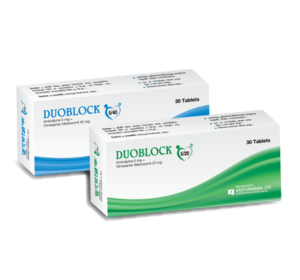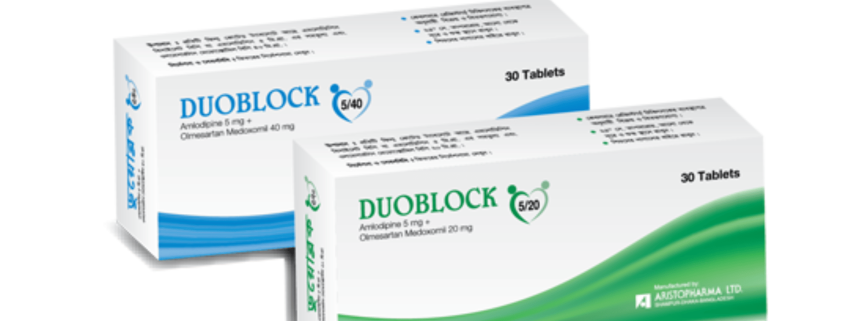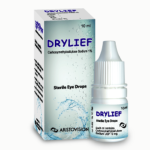Duoblock (Amlodipine Besilate + Olmesartan Medoxomil)

Therapeutic Group : Cardiovascular
Presentation:
Duoblock 5/20 Tablet: Each film coated tablet contains Amlodipine Besilate BP equivalent to Amlodipine 5 mg and Olmesartan Medoxomil BP 20 mg.
Duoblock 5/40 Tablet: Each film coated tablet contains Amlodipine Besilate BP equivalent to Amlodipine 5 mg and Olmesartan Medoxomil BP 40 mg.
Indications:
Duoblock tablet is indicated for the treatment of hypertension, alone or with other antihypertensive agents. Duoblock tablet may also be used as initial therapy in patients who are likely to need multiple antihypertensive agents to achieve their blood pressure goals.
Dosage & Administration:
Initial Therapy: The usual starting dose of Amlodipine and Olmesartan combination tablet is 5/20 mg once daily. The dose can be increased after 1 to 2 weeks of therapy to a maximum dose of one 10/40 mg tablet once daily as needed to control blood pressure. Initial therapy with this combination product is not recommended in patients >75 years old or with hepatic impairment. Amlodipine and Olmesartan combination tablet may be taken with or without food. Amlodipine and Olmesartan combination tablet may be administered with other antihypertensive agents.
Replacement Therapy: Amlodipine and Olmesartan combination tablet may be substituted for its individually titrated components. When substituting for individual components, the dose of one or both of the components can be increased if blood pressure control has not been satisfactory.
Add-on Therapy: Amlodipine and Olmesartan combination tablet may be used to provide additional blood pressure lowering for patients not adequately controlled with amlodipine (or another dihydropyridine calcium channel blocker) alone or with olmesartan medoxomil (or another angiotensin receptor blocker) alone.
Contrainidications:
Hypersensitivity to any of the component of this combination product. Do not co-administer aliskiren with Amlodipine & Olmesartan combination in patients with diabetes.
Side effects:
The overall incidence of adverse reactions on therapy with Amlodipine and Olmesartan combination tablet was similar to that seen with corresponding doses of the individual components of this combination product, and to placebo. The reported adverse reactions were generally mild and seldom led to discontinuation of treatment (2.6% for Amlodipine and Olmesartan combination tablet and 6.8% for placebo). These included hypotension, orthostatic hypotension, rash, pruritus, palpitation, urinary frequency, and nocturia. Edema is a known, dose-dependent adverse effect of amlodipine but not of olmesartan medoxomil.
Drug interaction:
The pharmacokinetics of amlodipine and olmesartan medoxomil are not altered when the drugs are co-administered. No drug interaction studies have been conducted with Amlodipine and Olmesartan combination tablet and other drugs, although studies have been conducted with the individual amlodipine and olmesartan medoxomil components as described below, and no significant drug interactions have been observed.
Drug Interactions with Amlodipine
In vitro data indicate that amlodipine has no effect on the human plasma protein binding of digoxin, phenytoin, warfarin, and indomethacin.
Effect of Other Agents on Amlodipine
Cimetidine: Co-administration of amlodipine with cimetidine did not alter the pharmacokinetics of amlodipine. Grapefruit juice: Co-administration of 240 ml of grapefruit juice with a single oral dose of amlodipine 10 mg in 20 healthy volunteers had no significant effect on the pharmacokinetics of amlodipine. Antacid: Co-administration of the antacid with a single dose of amlodipine had no significant effect on the pharmacokinetics of amlodipine. Sildenafil: A single 100 mg dose of sildenafil in subjects with essential hypertension had no effect on the pharmacokinetic parameters of amlodipine. When amlodipine and sildenafil were used in combination, each agent independently exerted its own blood pressure lowering effect.
Effect of Amlodipine on Other Agents
Atorvastatin: Co-administration of multiple 10 mg doses of amlodipine with 80 mg of atorvastatin resulted in no significant change in the steady state pharmacokinetic parameters of atorvastatin. Digoxin: Co-administration of amlodipine with digoxin did not change serum digoxin levels or digoxin renal clearance in normal volunteers. Ethanol (alcohol): Single and multiple 10 mg doses of amlodipine had no significant effect on the pharmacokinetics of ethanol. Warfarin: Co-administration of amlodipine with warfarin did not change the warfarin prothrombin response time.
In clinical trials, amlodipine has been safely administered with thiazide diuretics, beta-blockers, angiotensin-converting enzyme inhibitors, long-acting nitrates, sublingual nitroglycerin, digoxin, warfarin, non-steroidal anti-inflammatory drugs, antibiotics, and oral hypoglycemic drugs.
Drug Interactions with Olmesartan Medoxomil
No significant drug interactions were reported in studies in which olmesartan was co-administered with digoxin or warfarin in healthy volunteers. The bioavailability of olmesartan was not significantly altered by the co-administration of antacids [Al(OH)3/Mg(OH)2]. Olmesartan medoxomil is not metabolized by the cytochrome P450 system and has no effects on P450 enzymes; thus, interactions with drugs that inhibit, induce, or are metabolized by those enzymes are not expected.
Non-Steroidal Anti-inflammatory Agents including Selective Cyclooxygenase-2 inhibitors (COX-2 inhibitors): In patients who are elderly, volume-depleted (including those on diuretic therapy), or with compromised renal function, co-admininstration of NSAIDs, including selective COX-2 inhibitors, with angiotensin II receptor antagonists, including olmesartan medoxomil, may result in deterioration of renal function, including possible acute renal failure. Dual Blockade of the Renin-Angiotensin System (RAS): Dual blockade of the RAS with angiotensin receptor blockers, ACE inhibitors, or aliskiren is associated with increased risks of hypotension, hyperkalemia, and changes in renal function (including acute renal failure) compared to monotherapy. Colesevelam hydrochloride: Concurrent administration of bile acid sequestering agent colesevelam hydrochloride reduces the systemic exposure and peak plasma concentration of olmesartan. Lithium: Increases in serum lithium concentrations and lithium toxicity have been reported during concomitant administration of lithium with angiotensin II receptor antagonists, including olmesartan.
Use in special groups:
Use in Pregnancy & Nursing Mothers: Pregnancy Category D. Because of the potential for adverse effects on the nursing infant, a decision should be made whether to discontinue nursing or discontinue the drug, taking into account the importance of the drug to the mother.
Use in children: The safety and effectiveness in paediatric patients have not been established.
Use in elderly patients: Elderly patients have decreased clearance of amlodipine. Starting amlodipine
or adding amlodipine at 2.5 mg in patients >75 years old is recommended. The lowest dose of combination is 5/20 mg; therefore, initial therapy with combination is not recommended in patients >75 years old.
Renal impairment: There are no studies of amlodipine & olmesartan combination in patients with renal impairment.
Hepatic impairment: There are no studies of amlodipine & olmesartan combination in patients with hepatic insufficiency. Use caution when administering amlodipine & olmesartan combination to patients with severe hepatic impairment.
Packing:
Duoblock 5/20 Tablet: Each box contains 30 tablets in alu-alu blister pack.
Duoblock 5/40 Tablet: Each box contains 30 tablets in alu-alu blister pack.



